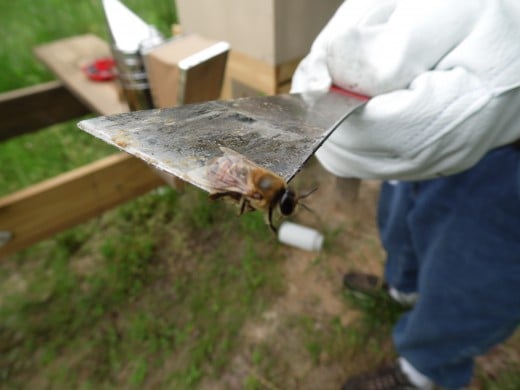First Year Beekeeper
Welcome to the Farm
Starting with two nucleus hives, I will attempt to learn the ropes of beekeeping. A nucleus hive, or 'nuc box', is a small hive used to start a larger hive. I am located in a rural area of west central Georgia, on four acres, with no large crop farming operations nearby. My bee yard is bordered by hundreds of acres of forest and pasture land. After six months of internet research, I have decided to use a more natural approach with my hives. This means using NO synthetic chemicals, only naturally occurring compounds.
Honey Bees

Two New Hives
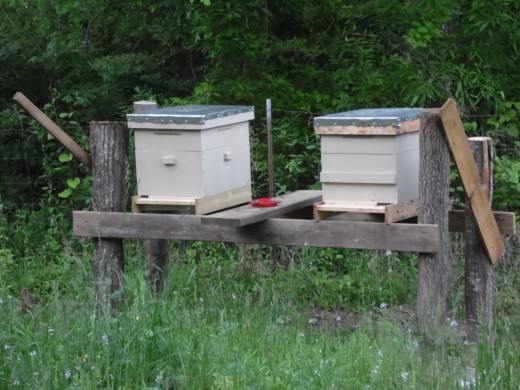
The Setup
I set up a small hive stand using some free tree trunks from the woods near my bee yard. I have two hives which each consist of a screened bottom board, a deep hive body, a hive top feeder, and a telescoping top cover. I am using wooden frames with plastic, wax coated Ritecell foundation. I have entrance reducers on both hives that allow for a three inch opening. As for beekeeping equipment, I have gathered together a smoker, helmet with veil, hive tool, bee brush, elbow length bee gloves, and a long sleeved white cotton shirt.
This is a seasonal blog that will follow my efforts to learn natural beekeeping from spring 2014 until spring 2015. I will update the blog as new information becomes available. I am also attempting to catch a swarm of bees in my swarm trap. Starting with zero experience, I don't have any idea what will happen. Be it good or bad, I will post it all right here for the whole world to see.
New Beekeeper
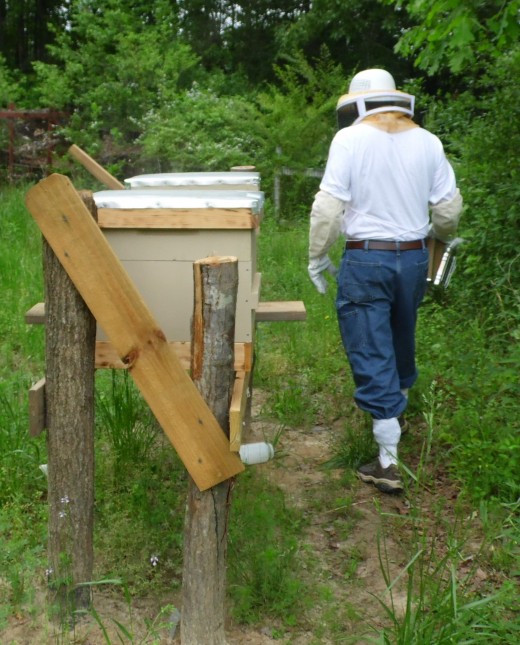
Installing the Nucs, April 20, 2014
I picked up two nucleus hives from a local honey bee farmer, Sweetwater Honey Farm, in nearby Douglasville, Georgia. The pickup was on Saturday, and the beekeeper was supposed to install the nucs into my hives. As luck would have it, the weather did not cooperate yesterday, and I was only able to grab the nucs and bring them home in the rain. So of course now I had to transfer the frames full of bees from the nucs into my waiting hives.
While I have known all along I would have to one day stick my hands in a bee hive, I had not planned on doing it today. I must admit that getting stung and accidentally killing the queen were my two worst fears. As an inexperienced beekeeper, my guess has always been that it is normal to get stung dozens of times each year. While this in itself doesn't really bother me, it is the unknown of when it will happen that has me a bit nervous. I have been stung many times by wasps and yellow jackets, so I kind of know what to expect. Nothing to worry about, right?
I put the nucs near the hives this morning and opened the entrances. By lunch time the bees were flying in and out normally. The weather was perfect, so I suited up for the transfer. My outfit is a long sleeved cotton shirt, long pants, a helmet and veil, and elbow length gloves. The shirt is tucked in and the pants are tucked into my socks. I noticed in my trial runs that the veil sometimes rode up in the rear, leaving the back of my neck exposed. A collared shirt would probably fix this, but for now I just had my wife pin it to my shirt.
I got the smoker lit and laid a tiny puff of smoke across each nuc box entrance. I sat the first nuc box up on the hive stand next to the first hive. I opened the lid and smoked the bees a little. I slowly transferred the first frame into the hive. At this point a single bee began furiously ramming my veil over and over. She circled around and around, trying to find a way to get to me. I puffed her with a little smoke, but she would not let up. Not sure of my level of protection, combined with the unnatural feeling of sticking my hands in a beehive got me a bit unnerved at that point.
I slowly walked away from the hives and continued to calmly blow small puffs of smoke at my attacker. The bee lost interest after a minute or so and finally flew away. A little more confident in my armor, I convinced myself to return to the hives and at least work on the transfer until I got stung. I made my way back over and completed the transfer of each nucleus box into the permanent hives. Never got stung one time. As a beginner, I tried to be careful not to use too much smoke, and to move slowly. I was so nervous that I didn't get a great look at any of the frames, but I did see lots of capped brood.
I filled up the hive top feeders with 1:1 syrup and closed up the hives. I plan to make a better inspection after a week or two. Maybe I can get a better look at what is going on inside the colonies.
Ant Free Sugar Syrup with Fat Bee Man
Catch Your Own Free Honey Bees
- Free Honey Bees
I am a new beekeeper and the thought of being able to catch free swarms of honey bees is very tempting. Join me as I attempt to lure a swarm into my homemade honey bee trap!
Fat Bee Man Natural Brood Builder
May, 2014
I fed both hives (Hive A and Hive B) 1:1 syrup with Fat Bee Man's essential oil brood builder for one week. The flow started as the blackberries and poplar trees bloomed. Both hives built up to about eight frames quickly. By the end of May, both were at least twelve frames of bee covered combs. I took three frames from each hive and started two small five frame nucs.
Honey Bee Hive Inspection
Click thumbnail to view full-size



Bee Yard June 2014
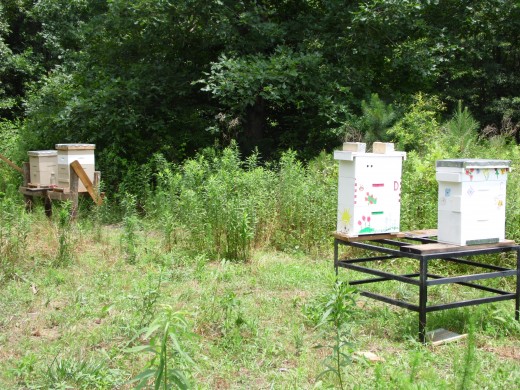
Honey Bees at Work

June, 2014
The two five frame nucs (Hive C and Hive D) made their own queens and both started laying. Hive B became queenless and I added an open brood frame twice. Hive A was busting with bees and filled the brood chamber with nectar. This hive swarmed near the end of June.
Swarm of Honey Bees from Hive "A"


Honey Bees

July, 2014
A queenless Hive B could not seem to make themselves a new queen. I ended up combining the small, queen right Hive C with B to provide a laying queen. Hive B began to improve right away. Checked mite levels using a powdered sugar roll. Found five mites in a one hundred bee sample. Decided to start a six week powdered sugar shake mite treatment.
Combining Honey Bee Hives
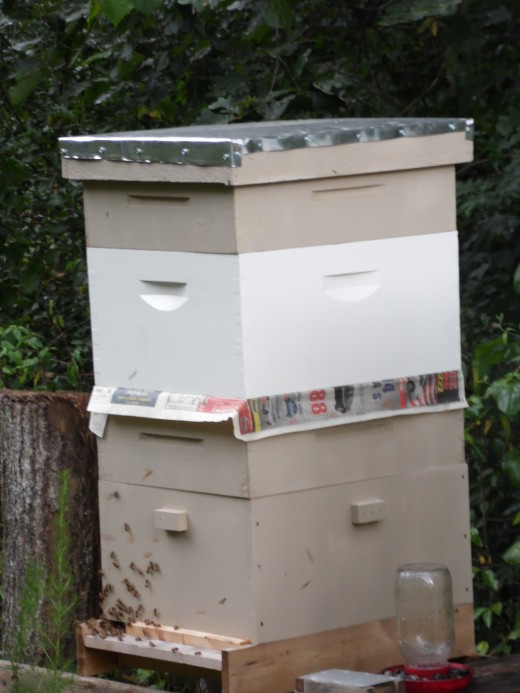
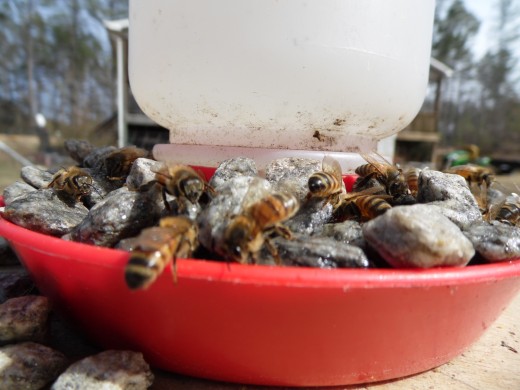
Hive Inspections June 2014
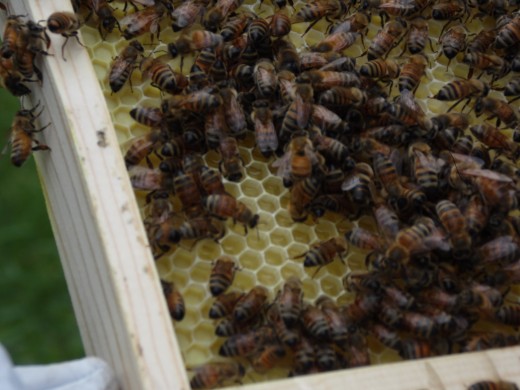
August, 2014
Started a six week powdered sugar shake mite treatment. Followed an outline for the treatments that I found online. I plan to check the mite levels again after the treatment is complete.
Powdered Sugar Shake for Mites
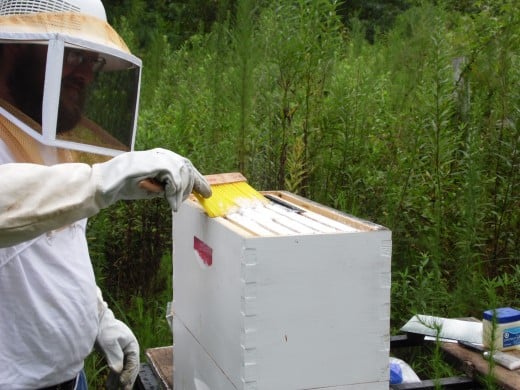
September, 2014
I stole some capped honey from the hives earlier in the year. I am feeding 2:1 syrup to make sure the bees are prepared for winter. I finished the six week powdered sugar treatment and checked mite levels. I found one mite in a one hundred bee sample. All three hives seemed to have a lowered mite level. Finally got stung a couple of times, and it was not what I was expecting. The pain was minimal, and I had forgotten it in minutes.
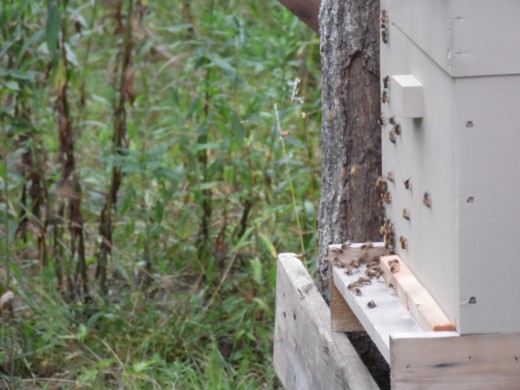
October, 2014
Checked mite levels again and found them to be high. I got some oxalic acid and performed an OA dribble based on some online information I found. Experienced an overwhelming mite fall as noted on a sticky board under the screened bottom boards.
Natural Comb on Starter Strip
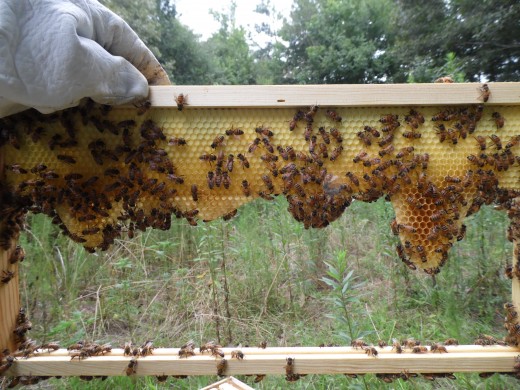
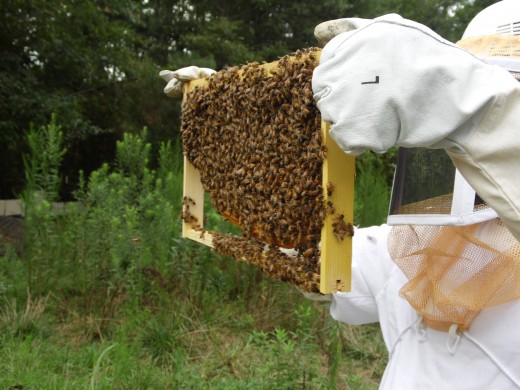
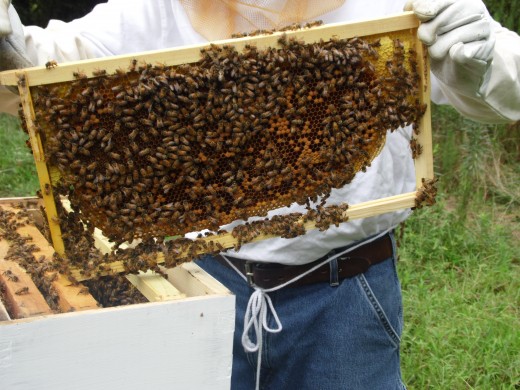
November, 2014
The small nuc, Hive D, began getting robbed furiously. I installed a robbing screen, but it only deterred the robbers for a little while. We had a very cold night and Hive D was gone, left with only the dead queen surrounded by about twenty bees still stuck to a comb.
December, 2014
Found both Hive A and B empty, with only a few scattered bees. Both hives still had honey and pollen stored. Some folks on the honey bee forum suggested the hives had become overrun with mites. I inspected the hives and found tons of white 'poop' from the mites. I also observed thousands of mites on the board under the screened bottom. Looks like I still have some learning to do.
Lessons Learned
The most important lesson I learned in my first season is to know your mite levels and treat for them. In the future, I will use an alcohol wash to test mite levels and try to keep mites under two percent. As far as the treatments themselves, I have found that a few popular treatments contain natural ingredients. I hope to use those treatments to control my mite populations next season.
Also, be sure the person giving you advice has the experience to know the right advice. Believe it or not, I have seen folks giving tons of advice on forums that have never even owned honey bees!
I have ordered replacement bees for next year and will be starting with five nucleus colonies.


